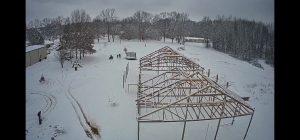As I referenced yesterday, the information on frost heaving, it’s theory and possible solutions to the problem, are brought to you by Harris Hyman, P.E., as written in the July 1994 issue of Practical Engineering. In finding solutions to a problem, it is often necessary to dig into why the problems occur in the first place. If you missed yesterday’s blog, I encourage you to go back and read it prior to this one, and be sure to come back tomorrow for the final installment in the subject of: frost heaving.
Provided by Harris Hyman, P.E.
Ice is fierce stuff. While most substances expand as they become warmer, ice actually expands as it gets colder, with the maximum expansion at about 28°F. When ice is confined, it can exert pressures from 20,000 to 80,000 pounds per square foot. There is almost no way to contain pressures like this; other solutions must be found.
The theory about ice lenses corresponds pretty well with the experience of engineers and excavating contractors. The most interesting implication is that heaving needs two things: cold and water.
 This fact gives us our solution: Remove the water. Drainage is the one solution to heaving that does work most of the time. With post construction drainage, this means allowing the water that collects in the postholes to have a way to get out of the holes before it freezes. This usually means cutting a trench along the line of holes, which tends to defeat the conceptually easy construction of digging postholes, but it does do the job. What a pain!
This fact gives us our solution: Remove the water. Drainage is the one solution to heaving that does work most of the time. With post construction drainage, this means allowing the water that collects in the postholes to have a way to get out of the holes before it freezes. This usually means cutting a trench along the line of holes, which tends to defeat the conceptually easy construction of digging postholes, but it does do the job. What a pain!
The two worst methods for dealing with frost heaving are the heated foundation and the locking bar. I call the heated foundation “structural use of energy” — burning irreplaceable fuel, warming the soil around the building, to prevent frost damage and hold a building together. This is both extremely expensive over a long period of time and socially undesirable. Even though it cuts down initial construction costs, it should not be encouraged.
The locking bar is a bit of foolishness that seems to keep appearing on construction sites. This is a cross-bar nailed or lag-screwed to a post, usually about 2 feet below grade. Apparently the builders think that this helps hold the post down, but it is usually above the ice lens and actually helps lift the post.
Hmmm, ok – now you have a bit of background from Mr.Harris, a professional engineer on what causes frost heaves and what some builders do to offset it, which apparently does more to increase the possibility of a building heaving, than prevent it. So what does this all mean for post frame construction, or any wood framed building for that matter? Stay tuned for Part 3 of 3 on Frost Heaves….come back tomorrow!







To avoid eventual grade board rot we were planning on setting the grade board 1″ below the inside concrete level, letting the floor concrete run under the grade board, and then slope away outside the building for 6″. Can this cause a heaving problem as the concrete an not slip vertically up and down the grade board?
James ~ This sounds like a lot of effort, to begin with. Yes, it could cause frost heave issues. A properly pressure preservative treated grade board (aka skirt board or splash plank) is never going to rot anyhow – so you are probably trying to solve an unfounded fear. Easier solutions – order the grade boards treated to a UC-4B level, this is the same level of pressure treatment used on the building columns; or wrap the grade boards with Plasti-Skirt (for more information: https://www.plastisleeve.com/plasti-skirt-info/).